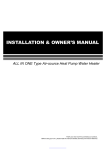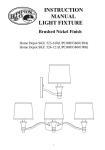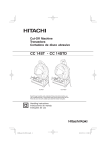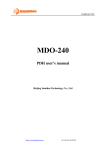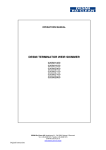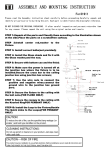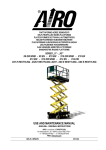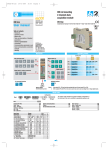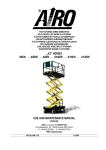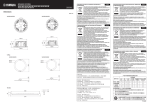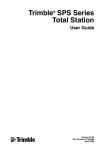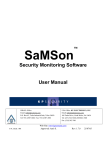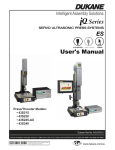Download Usermanual
Transcript
TEF 2650/2655 COMMANDER SEARCHLIGHT HALOGEN & HRI INSTALLATION AND USER MANUAL IMPORTANT TUM 1094 REV. F. 12.11.2015 Please read this manual carefully before installing the product. Tranberg AS | P.O. Box 8033 | N-4068 Stavanger | Norway | Tel.: (47)51 57 89 00 | Fax.: (47)51 57 89 50 E-mail: [email protected] | www.tranberg.com Tranberg Systems | Hjulmagervej 15C | 7100 Vejle | Denmark | Tel.: (45) 75 85 83 80 E-mail: [email protected] | www.tranbergsystems.com COMMANDER SEARCHLIGHT - INSTALLATION AND USER MANUAL SAFETY INSTRUCTIONS • The intense light output may damage eyes when stared directly into the light. • Never use force to move the searchlight head on a motorized unit. This may damage the power train inside the motor unit. • Never open a searchlight head while energized. High voltage is present. • Always wait until light source and other components have cooled before touching any part. • • Any type of light source reaches a very high temperature. Do not touch if warm. Never touch with bare skin as this reduces light output. • The motorized searchlight moves both vertically and horizontally. Be aware of any personnel close to the searchlight when testing or operating. GENERAL WARRANTY CERTIFICATE Tranberg AS gives normally a general warranty on Tranberg products valid for 12 months from delivery date. General the products will (a) Confirm to the purchase order, (b) Be free from liens, claims and encumbrances, (c) Be free from failures or defects which may arise from defective design, materials or workmanship. The warranty is based on that “The assembly- and maintenance instruction”, attached with the product, is fulfilled, and does not cover damage caused by misuse or lack of proper maintenance and care. Regards terms of delivery: Other agreements than standard terms of delivery are to be in writing. Official terms of delivery, NL-01 are valid. Regarding the bulb, please look at the warranty papers following the bulb. This must be filled in and returned with the bulb to Tranberg AS. Page 2 COMMANDER SEARCHLIGHT - INSTALLATION AND USER MANUAL TABLE OF CONTENTSNTS: CONTENTS 1. SYSTEM OVERVIEW 4 2. OPERATION 5 3 MAINTENANCE 7 4 INSTALLATION 7 5 SPECIAL PROCEDURES 8 6 FAULT FINDING 7 CONNECTIONS, SETTINGS AND INDICATORS 8 10 TECHNICAL DATA 11 14 DRAWINGS16 600A101119 - TEF 2650 HALOGEN ASSEMBLY DRAWING 16 600A101119 - PART LIST FOR ASSEMBLY DRAWING 17 600A101119 - PART LIST FOR ASSEMBLY DRAWING 18 600A103633 - LAMP HOUSING TEF 2650 HALOGEN 19 600A103633 - PART LIST FOR LAMP HOUSING 20 600A102892 - DIMENSIONS FOR TEF 2640/ 2650 2000W / 3000W 21 600A102448 - DIMENSIONS - TEF 2640/ 2650 SEARCHLIGHT, 2000W 22 600A102893 - DIMENSIONS - TEF 2640/ 2650 SEARCHLIGHT, 250/1000W 23 600A106002 - DIMENSIONS - TEF 2655 SEARCHLIGHT, 250W / 1000W 24 600A104858 - JUNCTION BOX TEF 2650 HALOGEN 25 600A104860 - JUNCTION BOX TEF 2650/ 2655 HALOGEN 24 VDC 26 600A102101 - CONTROL PANELS DIMENSIONS AND CUT-OUTS 27 600A105539 - SYSTEM EXAMPLE, WIRING DIAGRAM 28 600A104949 - SEARCHLIGHT MAIN JUNCTION BOX, WIRING DIAGRAM 29 600A104881 - SEARCHLIGHT HEAD 1000/2000/3000W, WIRING DIAGRAM 30 600A105612- SEARCHLIGHT MAIN JUNCTION BOX, WIRING DIAGRAM 31 600A105641- REACTOR ENCLOSURE FOR HRI, GA AND WIRING DRAWING 32 600A105720 - GA DRAWING OF JUNCTION BOX FOR SEARCHLIGHT HRI 33 600A105721 - WIRING DIAGRAM FOR SEARCHLIGHT HRI, MAIN JUNCTON BOX 34 600A105722 - WIRING DIAGRAM FOR TEF 2650 HRI, SEARCHLIGHT HEAD 35 Page 3 COMMANDER SEARCHLIGHT - INSTALLATION AND USER MANUAL 1. SYSTEM OVERVIEW MULTI SEARCHLIGHT CONTROL PANEL TEF 2613 1 2 5 3 6 4 7 2 5 3 6 4 7 MULTI SEARCHLIGHT CONTROL PANEL TEF 2613 MULTI SEARCHLIGHT CONTROL PANEL TEF 2613 MULTI SEARCHLIGHT CONTROL PANEL TEF 2613 1 8 1 8 2 5 3 6 4 7 1 8 2 5 3 6 4 7 3 7 MULTI SEARCHLIGHT CONTROL PANEL TEF 2613 1 8 4 8 2 5 3 6 4 7 8 1 5 2 6 1 5 2 6 1 5 2 6 1 5 2 6 1 5 2 6 LIGHT NARROW FAST LIGHT NARROW FAST LIGHT NARROW FAST LIGHT NARROW FAST LIGHT NARROW IGNITION WIDE SLOW IGNITION WIDE SLOW IGNITION WIDE SLOW IGNITION WIDE SLOW IGNITION WIDE SLOW DIM HOME/ GROUP ON/STBY DIM HOME/ GROUP ON/STBY DIM HOME/ GROUP ON/STBY DIM HOME/ GROUP ON/STBY DIM HOME/ GROUP ON/STBY 3 7 4 8 3 7 4 8 3 7 4 8 3 7 4 8 FAST 600A105424 The Tranberg Commander Searchlight uses a serial communication network to control and monitor the searchlights. This makes it possible to freeely choose and combine the number of searchlights and panels. All panels can control all searchlights, one at a time, by using selection buttons on the panel. The communication network is connected as a bus topology, i.e. the communication cable is connected from unit to unit as a chain. In that way, all units can communicate with every other unit, and can listen to every message sent over the network. Each unit connected to a bus must be uniquely identified by a number (address). This address is set either by thumbwheels, or programmed and stored in internal non-volatile memory. One of the units has to control the communication on the bus. The unit performing this function is called a master, and in the Commander Searchlight system this function is assigned to the panel with address ‘0’. When the master is powered up it will check what units are present on the bus by querying each unit. If one unit is not powered up in this phase, and thus does not answer the query, it will be regarded as not-present and will not be able to communicate with the other units on the bus. It is therefore important that all searchlights are powered up before the panels. Page 4 SEARCHLIGHT MOTION CONTROL: The Commander Searchlights are equipped with positional sensors for both motors/axes. This makes it possible to let the searchlight automatically move to pre-defined positions, and also results in a smooth, controlled motion. The searchlights can rotate more than one full revolution, approx. 370°, and the end stop is located at the connection box. The vertical movement is from approx. 15° upwards to approx. 35° downwards. TYPES OF SEARCHLIGHTS / LIGHT SOURCES: Available light sources: • Halogen has a wider, long range beam. Warm-white colour. Is powered directly by 230VAC. • Xenon has a narrow, extra long range beam. Daylight colour, part of the spectrum is ultraviolet (UV) making it useful for seeing ice (visual ice detection). Needs a separate power supply and cabling. • HRI (metal-halide) has a high light output with daylight colour, re sembling a xenon light. Has some restrictions regarding power on/off timing (reach full light output after 1 – 2 minutes on-time). Needs a separate ballast between 230VAC and lamp. COMMANDER SEARCHLIGHT - INSTALLATION AND USER MANUAL 2. OPERATION 2.1 START-UP PROCEDURE If, for some reason, this is not possible, please do a manual re-scan as described in chapter 5.2 after all units are powered up. Power-up: Apply power in the following sequence: 1. Apply the 230 VAC power to the searchlights first. 2. Apply the 24 VDC power to the panels next. If the panels have several separate supplies, ensure that the master panel is powered up last. The panels will be in the ‘on’ mode when powered up. 2.2 CONTROL PANEL A searchlight will do a position reference search when powered up and receiving a bus query message from the master panel (a bus re-scan). It will slowly turn to the right and tilt upwards until the end positions is reached. The searchlight will not respond to joystick commands from a panel until it has finished this position search phase (but the light can be turned on and off). 3 7 MULTI SEARCHLIGHT CONTROL PANEL TEF 2613 1 4 2 5 3 6 1 5 2 6 LIGHT NARROW 4 7 8 3 7 4 8 FAST 5 9 IGNITION WIDE SLOW ON/STBY DIM HOME/ GROUP 1 10 600A102101 2 GENERAL Any user can control any searchlight at any time. When the lamp on a searchlight is turned on, it will be indicated in all the other panels by the indicator for that searchlight (In the select buttons) flashing slowly. If the same search¬light is selected from another panel (the select button is pressed), then the other panel gains control over that searchlight, and the first panel will loose its control. As this happens the searchlight will maintain the previous lamp on or off setting, but the speed setting will be dependent on the setting of the new control panel. When the control panel is turned off, the searchlights last operated from this panel will automatically be turned off. NOTE: Slow flashing is 1 sec on, 1 sec off. Fast flashing is 2 flashes per second. 1. “ON/STBY” or “POWER” (2612 / 2613 / 2614) On / Standby button, activates the panel. The backlight will turn on. Press momentarily to turn on, press and hold for 1 sec to go to standby. In standby the panel will turn off all searchlights that was used by that panel. The yellow indicator will light steady if it is a master panel, or flash slowly if it is a slave panel. 8 6 2. “DIM” (2612 / 2613 / 2614) Adjusts the panel backlight level. Press shortly yo change level one step, press and hold to change the level to min or max. 3. SEARCHLIGHT SELECT BUTTONS 2613: To select which searchlight you want to operate, press the buttons on the top row. The first is used to select searchlight no. 1 and 5. The first press selects searchlight no. 1, press once more (within a second) to select searchlight no. 5. For the three other buttons works the same way. It is only possible to select searchlights that are connected. The panel may operate up to 8 searchlights and the system will automatically detect the number and adresses of the searchlights that are connected. 2614: To select which searchlight you want to operate, press the buttons on the top row. The first (‘A’) is used to select searchlight no. 1. The first press selects the first lightsource of searchlight no. 1, press once more (within a second) to select the second lightsource. For the three other buttons it works the same way. It is only possible to select searchlights that are connected. The panel may operate up to 4 searchlights (addresses 1 to 4) and the system will automatically detect the number and adresses of the searchlights that are connected. Page 5 COMMANDER SEARCHLIGHT - INSTALLATION AND USER MANUAL 2 OPERATION 4. 10. “LIGHT” (2612/2613/2614) Turn light on or off. A green indicator light will light steady if the lamp is on. Flashes rapidly when the group function is activated. 5. “IGNITION” (2612/2613/2614) Press to ignite the xenon lamp. Activates the ignitor as long as the button is held. Not used for other lamp types. The searchlight will automatically release the ignition relay after 10 seconds to save the xenon lamp from excessive wear. 6. “NARROW” AND “WIDE” (2612/2613/2614) Adjusts the lamp focus. Will change the beam from wide to narrow or backwards. Applicable only for searchlights with motor focus. Press and hold to change focus. The focus motor will automatically stop at each end position. 7. HOME: Move to “home” If only one searchlight is selected (or has been used from a panel), a short press on this button will command the searchlight to go to its (preset) home-position. A long press (> 5s) will set the searchlight’s current position as the new home position for that searchlight. GROUP: Move several searchlights If two or more searchlights have been turned on from the same panel, a short press on this button will start the group-function. The selected searchlights will then move simultaneously. INDICATOR TEST: 1. To see if all indicators on the front of the panel are working, pro ceed as follows: 2. Turn off panel with the ‘ON/STBY’ button. POSITION INDICATORS (2612/2613/2614) Arrow left and right: Steady light: The searchlight is in the sector left or right for the home position. Slow flashing: The searchlight is at the normal left or right end position. Fast flashing: The searchlight has stopped due to mechanical overload or at the end limit switches. Square: Steady light: The searchlight is at its horizontal home position. Slow flashing: The searchlight is at its horizontal and vertical home position. Fast flashing: The panel has sent a ‘set home position’ com- mand to the searchlight. 8. “HOME / GROUP” (2612/2613/2614): DUAL FUNCTION: 3. Press and hold the ‘ON/STBY’ button for at least 5 seconds. 4. While holding the ‘ON/STBY’ button, press (and release) the ‘DIM’ button shortly. 5. Release the ‘ON/STBY’ button. All indicators on the front of the panel will now flash rapidly. 6. If joystick or buttons are operated during this test, a corresponding LED (s) will extingwish as long as the button is held. 7. Press (and release) shortly the ‘ON/STBY’ button to exit lamp test mode and to turn on panel. NOTE: Slow flashing is 1 sec. on, 1 sec. off. Fast flashing is 2 flashes per second. JOYSTICK (2612/2613/2614): Left – right. Up for light downwards, down for light upwards. 9. “FAST” AND “SLOW” (2612/2613/2614): Adjust motor speed. 9 Steps, 5 Indications Speed 1 slow 2, 3 4, 5, 6 7, 8 9 fast Fast Slow MULTI SAR SEARCHLIGHT CONTROL PANEL TEF 2614 SINGLE SEARCHLIGHT CONTROL PANEL TEF 2612 A B C D LIGHT NARROW FAST LIGHT NARROW FAST IGNITION WIDE SLOW IGNITION WIDE SLOW ON/STBY DIM HOME/ GROUP ON/STBY DIM HOME/ GROUP ! WARNING! UV/IR LIGHT 600A102101 TEF 2612 Single searchlight control panel Page 6 TEF 2614 SAR searchlight control panel COMMANDER SEARCHLIGHT - INSTALLATION AND USER MANUAL 3 MAINTENANCE 4 INSTALLATION 3.1 CLEANING 4.1 MECHANICAL INSTALLATION PANEL: The control panel may be cleaned with a mild detergent on any parts. SEARCHLIGHTS PHYSICAL PLACEMENT: SEARCHLIGHT: Keep the searchlight and lens clean. Use only water and soft cloth to clean the searchlight. Clean the front glass / lens only when the light is off and has cooled down. If necessary, clean the mirror using alcohol. Ensure that all remains of the cleaning solvent are removed. Use only a soft cloth to clean the mirror. 3.2 LUBRICATION The lubrication point at the bottom of the U-pieces should be greased every two years. Use grease which is resistant to temperatures down to –50°C. 3.3 MECHANICAL Check all external screws on the searchlight periodically and tighten if needed. Control that the lamphouse moves smoothly and with low friction both horizontally and vertically. Do not overtighten the four bolts in which the lamphouse is hinged, as this may hinder the movement of the searchlight. Remove build-up of ice on and around the searchlight. The motor unit and the lamphouse optional have both an internally mounted heater to avoid condensation, but it is not designed for de-icing the searchlight. 3.4 ELECTRICAL SEARCHLIGHT: Clean and inspect the electrical connections to xenon lamp periodically. A layer of oxidation can build up as a result of lamp heating and cooling. Also inspect the other high current connections for bad contacts and overheating. Consider the end stop of the horizontal movement, the end stop is placed at the connection box, i.e. when the light head is facing in the same direction as the connection box. Also consider if there are sectors which should not be illuminated. 4.2 ELECTRICAL INSTALLATION - CABLING CABLING – COMMUNICATION NETWORK: 1. Use 2x twisted pair cable or 1x twisted pair + screen. Characteristic impedance: 100 – 250 ohms. Suitable cables types can be cables made for Profibus, Interbus, Ethernet, Cat5, or similar. 2. The communication network must be connected as a bus topology, i.e. from point to point (unit to unit). No loops or star connections are allowed. ( See drawing 600A105539) 3. No end terminations are necessary. 4. Connect A to A, B to B and Ref to Ref. Ref is also called Sh on some units. 5. The order of panels and searchlights along the bus can be freely chosen. Tip: A drawing of the system showing the order and addresses of the units can be of great help if troubleshooting should be necessary. NOTE1: Keep communication cables away from all power lines. NOTE2: Treat / regard Shield/Reference as a signal. It shall under no circumstance be connected to Ground or other Protective Earth potentials. See technical data for details of communication interface. Connections, communication cable RJ-45 1 2 3 4 5 6 7 8 Signal: Pin: 3 A 6 B 4 Ref 5 Ref RJ-45 A Ref Ref B Cable RS-485 Shield TIA 568-A: White/Orange Orange Blue White/Blue 1 2 3 4 5 6 7 8 A Ref Ref B Shield TIA 568-B: White/Green Green Blue White/Blue Use twisted pair cable with screen. Characteristic impedance: 100-250ohm Pin 1,2,7,8: Not connected 600A105512 CABLING - SEARCHLIGHT MAINS (230VAC): For halogen searchlights both power to the lamp as well as power to the motor unit are supplied through the same cable. Dimension the cable and fusing according to the wattage of the lamp. Note that halogen lamps have a large inrush current at power-up (due to low filament resistance when cold), so a slow fuse with same rating, or a fuse with a higher rating is recommended. Page 7 COMMANDER SEARCHLIGHT - INSTALLATION AND USER MANUAL 4 INSTALLATION 4.3 ELECTRICAL INSTALLATION - SETTINGS Address settings: 1. Each unit (searchlight or panel) must have its own unique address. Panels and searchlights have separate address spaces, i.e. a panel with setting ‘2’ does not interfere with a searchlight set to address ‘2’. 2. The addressed units (panels and searchlights) can be placed freely along the bus, they don’t have to be placed according to their address or in any special order. 5 SPECIAL PROCEDURES 5.1 IDENTIFYING THE MASTER PANEL For the following special procedures, the master panel need to be identified. The master panel can be recognized by the yellow indicator in the power button. When you turn off power by pressing this button, the yellow indicator will be continuously lit in the master panel. It will blink slowly (1 sec. on, 1 sec off) on a slave panel. 5.2 RE-SCAN OF NODES CONNECTED TO THE BUS 3. The address of searchlights are normally pre-set from factory. See chapter “changing address on searchlight” if changes are needed. The address can also be hardwired by the address-rotary switch in the connection box. If necessary, the master panel can do a bus scan when powered up using the following procedure: 4.4 STARTUP OF SYSTEM 1. Turn off the master panel using the power button. Release the button. The backlight will turn off. 1. Check that all connections are correct and no short-circuits or breaks. Check all 230VAC supply lines. Also check the 24VDC supply to the panels and other control modules. 2. Press and hold the power button for at least 5 seconds. 2. Turn on power first to the searchlight motor units, then the xenon power supplies, and at last the 24VDC supplies to the panels. If the panels are powered from separate supplies, then first apply power to the slave panels, then to the master panel. Check visually that each searchlight makes a positional scan right after the master panel is powered up. The master panel should now find all searchlights and panels, and be able to communicate with them. 3. Check movement and light on /off of all searchlights. (Note: Do not operate or use any panels or searchlights during this procedure. Ensure that all are powered up.) 3. While holding the power button, press and release the second select button (marked ‘2/6’ (2613) or ‘B’ (2614) ). (Repeat if necessary, until backlight turns on). 4. The panel backlight will now turn on, and it will start the scanning of the bus (it takes a couple of seconds). 5. Release the power button. 6. When the scan process is finished, the panel will show which searchlights are present on the bus by fast flashing the corresponding leds on the select buttons (upper row). 7. Turn on the panel by using the power button as usual. 8. Repeat the procedure if necessary. 5.3 ALTERNATIVE RE-SCAN PROCEDURE FOR PANELS DELIVERED FROM APRIL 2009 AND ONWARDS: If necessary, the master panel can do a bus scan when powered up using the following procedure: A panel can do both this alternate re-scan procedure as well as the previous procedure (ch. 5.1). (Note: Do not operate or use any panels or searchlights during this procedure. Ensure that all are powered up.) 1. Set all panels to standby (“turn off”) by using the on/stdby button. The backlight will turn off. Locate the master panel (see ch. 3.2), and turn it on again. 2. Press and hold both speed buttons (‘fast’ and ‘slow’) for at least 5 seconds. 3. On the 2613 and 2614 panels, the indicators in the ‘searchlight select’ buttons will start flashing in sequence. On the 2612 panels, the indicators in the speed buttons will flash in sequence. Release the speed buttons. 4. The sequential flashing will last for a couple of seconds, as long as the scanning of the bus is performed. When the flashing is finished, the system is ready for use. 5. Repeat the procedure if necessary. Page 8 COMMANDER SEARCHLIGHT - INSTALLATION AND USER MANUAL 5 SPECIAL PROCEDURES 5.4 RESET OF SEARCHLIGHTS 1. Remove power (230VAC) to the searchlight (motor unit), wait for approx. 10 sec, and reconnect the power. (It is not necessary to disconnect the xenon power supply). If several searchlights need to be reset, repeat this for each searchlight before commencing to step 2. Do a re-scan from the master panel. Alternatively, remove and reapply power (24VDC) to the panels, either all or at least the master panel. The searchlight will now move to the right and upwards to find the end positions, and back to center. If necessary, watch the searchlight at this stage to verify the movement. 5.5 RECALIBRATE END LIMITS ON SEARCHLIGHTS 1. Open the searchlight junction box and set DIP-switch no. 1 to ON. 2. Remove power (230VAC) to the searchlight (motor unit), wait for approx. 10 sec, and reconnect the power. (It is not necessary to disconnect the xenon power supply). If several searchlights need to be reset, repeat this for each searchlight before commencing to step 3. 8. Push power button once to turn on the panel. Check if the searchlight can be controlled on the new address. The procedure can be repeated if necessary. 9. If more searchlights are to be changed, disconnect the power to the current searchlight, and repeat the procedure from step 3. FINALIZING: 10. IMPORTANT: Turn the rotary switch on the rear of the master panel back to the initial (noted) setting. 11. Mount the master panel back in place, connect the power supply to all the searchlights. 12. Do a re-scan of the bus, either by disconnecting and reconnecting the power supply to the master panel, or by following the re-scan procedure described further up in this document. Repeat if necessary. 3. Do a re-scan from the master panel. Alternatively, remove and reapply power (24VDC) to the panels, either all or at least the master panel. The searchlight will now do a complete movement up – right – left – center/down to find the end limit positions, and back to center. If necessary, watch the searchlight at this stage to verify the movement. 4. Set the DIP-switch no. 1 back to OFF and close the junction box. 5.6 CHANGING ADDRESS ON A SEARCHLIGHT PREPARATION: 1. Identify the master panel. Unmount the master panel, so as to get access to the rotary swiches on the rear. IMPORTANT: Make a note of the settings of the switches 2. Disconnect the power supply to all the searchlights. (Leave the power supply to the panels connected). PROCEDURE: 3. Connect the power supply address shall be changed. to the searchlight whose 4. Turn off the master panel using the power button. Release the button. The backlight will turn off. 5. Set the rotary switch labeled ”N/A” on the rear, set it to one lower than the new address of the searchlight (address minus 1, e.g. set to ‘1’ if the searchlight is to be set to address ‘2’, i.e. respond to the first press of button ‘2/6’). 6. Press and hold the power button for at least 5 seconds. While holding the power button, push the button marked ”3/7” (a short normal push and release). This button can alternatively be pushed several times, until the panel backlight is lit. When the backligth is lit, release the power button. The panel will now send a special message to the searchlight. 7. Check the indicators in the searchlight select buttons (”1/5”, ”2/6”, ”3/7” and ”4/8”). After approx. 5 – 10 sec. one of them will flash fast (2 times pr. sec) to show the new address of the searchlight. Page 9 COMMANDER SEARCHLIGHT - INSTALLATION AND USER MANUAL 6 FAULT FINDING 6.1 GENERAL 6.5 PROBLEMS AT INSTALLATION 1. Check which searchlights and from which panels the problem exists on. Can the fault be isolated to a particular searchlight or panel? 1. Check correct wiring (A is always connected to A, likewise for B and Ref. No grounding of Ref or connected to protective earth). Tip: if one unit in the middle of the comm. network bus does not respond, it may be that A and B are swapped both for the incoming and the outgoing cable. 2. If it is a system with a radio control module (RCM), check if the same problems exists with the ordinary (wired) panels. 3. When changing a setting/address on a unit, remove and reapply power to let the change become operative. 2. Jerky movement (and/or light goes uncontrolled on/off) can be caused by electrical noise on the network. Check correct wiring, especially mix-up of Ref and A or B. 6.2 PROBLEMS WITH MOVEMENT 3. Two or several searchlights move simultaneously when only one is selected from the panel: Check the addresses of the searchlights (same address on two units). 1. No movement: Check if light is able to turn on/off: do a re-scan on the master panel (see ch. 5.2 or 5.3). 2. Limited or shifted range of movement: possible problems with end limit switches. Try resetting the searchlight (see ch. 5.4). 3. The searchlight moves with low speed only (And incorrect position indication on panel): Possible problems with position sensors. Try resetting the searchlight (ch. 5.4) or a recalibration of end limits (ch. 5.5). 4. Spurious movement when joystick or panel is not operated: Possible electrical noise or interference on the communication network. Check if this happens under special operation conditions of the ship or other equipment. Alternatively, try resetting the searchlight (ch. 5.4) 5. Not able to select a searchlight from any of the panels. Possible failure of power supply or power dip (230VAC) to the searchlight. Do a a re-scan on the master panel (see ch. 5.2 or 5.3). 6.3 PROBLEMS TURNING ON OR OFF THE LAMP 1. Check if movement functions normally. If yes, then the communication with the searchlight is OK and the fault may be in the lamp circuits: Check the lamp itself, electrical wiring and relays. If no, first try to reestablish the communication with the searchlight: Do a re-scan on the master panel (see ch. 5.2 or 5.3). 2. Check if green indicator in “light” button functions normally (toggles on/off when pushing the button). If yes, then the communication with the searchlight is OK and the fault may be in the lamp circuits: Check the lamp itself, electrical wiring and relays. If no, the communication network may be faulty or being influenced by interference, or the searchlight may have a power loss (230VAC). Try to reestablish the communication with the searchlight: Do a rescan on the master panel (see ch. 5.2 or 5.3). 3. Check relay in the lamp power supply circuit: Contactor in junction box, relay on motor drive electronics. 6.4 PROBLEMS WITH PANELS 1. A master panel is required to get the system to function. If the panel set to master is faulty, the system will not function. Change address on one of the other (slave) panels to ‘0’, remove and reapply power (to the panel), and the panel will function as master. See also ch. 5.2 and 5.3 for re-scan from the master panel. 2. If a button or a joystick is faulty, do the indicator test described in ch. 2.2. Page 10 4. Not possible to select any searchlight, or strange behaviour of the indicators on one or more panels. Check the addresses on the panels, two or more set at the same address. 5. Master panel: There shall be one and only one panel set to master (ADR = 0) in a system. If no panel is set as master, the system will appear “dead”, if more than one, the panels will have an unpredictable behaviour. 6. If several faults are present on a system, try to isolate one panel and one searchlight and get this to work, then add more units step by step. 7. To decide whether cabling or searchlight is erroneous, power a panel (set to master) with a 9V battery and connect the communication network directly to a searchlight. COMMANDER SEARCHLIGHT - INSTALLATION AND USER MANUAL 7 CONNECTIONS, SETTINGS AND INDICATORS 7.1 PANELS CONNECTIONS There are 3 different panel models: Versions with phoenix screw terminals: Connect ‘A/B’ to one pair and ‘Sh1/2’ to one pair. Alternatively: ‘A/B’ to one pair, screen to Sh1 or Sh2. 1. TEF 2612 Single (this panel can only control 1 searchlight, searchlight no. 1) 2. TEF 2613 Multi (the standard panel for control of up to 8 searchlights) 3. TEF 2614 SAR (Search And Rescue, can control 4 searchlights with 2 light sources each) All models are identical regarding outer dimensions and connections. The 2613 and 2614 panels have 13 keys, while the 2612 panel has 9 keys (It does not have the upper 4 searchlight select keys). Signal Alt. 1 Alt. 2 A Pair 1 Pair 1 B Pair 1 Pair 1 Sh (Reference) Pair 2 Screen Sh (Reference) Pair 2 Screen Version with RJ-45 connectors There are 2 versions of each of these panel models: Pin Color (TIA 568-A) Color (TIA 568-B) 1. Old version with phoenix type screw terminals as bus connector 2. New version with RJ-45 connectors as bus connector 1 White / Green White / Orange N/C 2 Green Orange N/C 3 White / Orange White / Green 4 Blue Blue Reference 5 White / Blue White / Blue Reference 6 Orange Green 7 White / Brown White / Brown 8 Brown Brown - - Comm. Port RS-485 600A104817 Made in Norway N/A ADR. 50091314 Part No.: 2613381100 Fault N/A N/C N/C Shield Settings ADR Address Mode 0 0 0 Master 0 1-7 1-7 Slave 1 0-7 8 - 15 2 0 0 Master 2 1-7 1-7 Slave 3 0-7 8 - 15 4 0 0 Master 4 1-7 1-7 Slave 5 0-7 8 - 15 Panel Type TEF 2613 TEF 2612 TEF 2614 For panels with RJ-45 connectors delivered before April 2009: Rotary Switch N/A New version B 24VDC - + - + Rx Search Light Operator Panel Status Tx Pwr. Rotary Switch 24VDC Old version (Delivered before April 2009) A SETTINGS For all panels with phoenix screw terminals and panels with RJ-45 connectors delivered after April 2009: Made in Norway N/A ADR. Comm. Port RS-485 Part No.: 2612341100 2613381100 Fault Rx 50091314 - + - + Status Tx Pwr. Search Light Operator Panel Shield Signal 600A102101 Settings ADR Address Mode Panel Type TEF 2613 0 0 0 Master 0 1-9 1-9 Slave 2 0 0 Master 2 1-9 1-9 Slave 4 0 0 Master 4 1-9 1-9 Slave TEF 2612 TEF 2614 Note: The addresses 10 – 15 are not available on these panels. Page 11 COMMANDER SEARCHLIGHT - INSTALLATION AND USER MANUAL 7 CONNECTIONS, SETTINGS AND INDICATORS INDICATORS Priority Power btn LED Fault LED Description 1 Fast flash Fast Power on or off. Network error: No messages received. 2 Fast flash Slow Power on or off. Network error: The module receives messages on the bus, but none to its own address. - Steady on Off Power off/standby, Master Panel - Slow flash Off Power off/standby, Slave Panel (Receives messages from master) - Off Off Power on, Master or Slave Panel If a master panel do not get any answers/messages from any other slave or node, then the master will signal ‘No messages received’. Slow flash: 1 sec. on, 1 sec off Fast flash: 2 blink per second. The yellow Rx and Tx LEDs shows the activity on the bus, and will flicker at normal bus activity. The green Power LED will light steady when 24VDC is applied / supplied. 7.2 SEARCHLIGHT MOTOR UNIT MODE There are 2 different versions of the motor unit: 1. Version 1 with internal electronics: Connections are on numbered screw terminals (See connection diagrams). No visible indicators or settings. Address setting is done via bus programming. See chapter 5.6 “Changing the address of a searchlight”. (Indicators on the internal electronics board behave similarly to the indicators on the new version 2 electronics: Pwr –> Pwr, Rx –> Rx, I2 –> CPU). ADR Fault Pwr CPU Rx Sh B A Sh B A Comm. Port RS-485 ON 123 4 Status 2. Version 2 (new) with electronics in the junction box NOTE: The following chapters apply to version 2 (new) only. CONNECTIONS Signal 6 A 5 B 4 Sh 3 A 2 B 1 Sh Comment Reference Reference Made in Norway MODE Mode ADR ON Fault Pwr 123 4 CPU Rx Sh B A Sh B A Comm. Port RS-485 L L L L N N N N Pin Status DIP switch Description 1 If set to one: Do a full positional re-scan at next power-up/bus query (deletes and replaces the previous memorized endpositions). 2-4 Not in use Searchlight 50091335 Rotary switch Address Description 0 Use the programmed address. To change see chapter “Changing address on a searchlight”. 1-9 Set address equal to number. 1 = 1 (A) on panel, 2 = 2 (B) on panel, etc. 600A104858 For safety reasons the motors in the searchlight will stop after 1.5 seconds without communication on the bus. Page 12 COMMANDER SEARCHLIGHT - INSTALLATION AND USER MANUAL 7 CONNECTIONS, SETTINGS AND INDICATORS INDICATORS: Rx (Yellow): shows the activity on the bus, and will flicker at normal bus activity Pwr (Green): light steady when the internal 24VDC is OK. CPU (Green): Priority CPU LED Description 1 Steady on Is on for 5 sec. when power is applied 2 Fast flash All OK and receiving messages from the bus master 3 Slow flash OK, but not receiving messages to itself from the bus - Off Fault (Red) Priority Fault LED 1 Description Steady on 1. Output stage of drive electronics has an overtemperature condition 2. During positional scan at power-up. If one of the conditions for fast or slow blinking occur at this phase, it will start blinking correspondingly. 2 Fast flash Overcurrent/overload at one or both motors. Will continue to blink fast until both motors are driven at the same time. 3 Slow flash Not receiving any messages to itself. Delayed 5 sec. after the CPU LED. - Off Normal condition 7.3 CONTROL MODULES SIM and RCM module: Priority Fault LED Description 1 Steady on Functional error: Can be several causes. 2 Fast flash Network error: No messages received. 3 Slow flash Network error: The module receives messages on the bus, but none to its own address. - Off Module and outputs OK. Page 13 COMMANDER SEARCHLIGHT - INSTALLATION AND USER MANUAL 8 TECHNICAL DATA SEARCHLIGHT Model: 2650/ 2655 Halogen 250W (Ø355) 2650/ 2655 Halogen 1000W (Ø355) 2650 Halogen 1000W (Ø510) 2650 Halogen 2000W (Ø510) 2650 HRI 1000W (Ø410) 890 mm 890 mm 1084 mm 1084 mm 959 mm Dimensions: Height: Width: 450 mm 450 mm 450 mm 450 mm 497 mm Height w/pedestal: 1490 mm 1490 mm 1684 mm 1684 mm 1559 mm Weight searchlight: 56 kg 56 kg 56 kg 56 kg 56 kg Electrical: Line input voltage (*): 230 VAC 202-254 VAC Line input current (max): 3A Standard cable gland dia.: 2 pcs. E204/2A/M20 6.4 – 11.8mm Ø Comm. interface: RS-485, Galvanically isolated Required cable impedance: typ. 100 – 250Ω Optical system: Lamp power: Working voltage ( other voltage on request ): Lamp lifetime (approx.): Luminous flux: Divergence: Range at 1 lux ( theoretical calculation ): Reflector diameter: Focal point distance: Tranberg Lamp Part No.: 250W 1000W 1000W 2000W 1000W 24V 230V 230V 230V 230V 300h 900h 900h 480h 12000h 12600 lm 21000 lm 21000 lm 50000 lm 90000 lm 6° 11° 7,9° 10,8° 2° - 7° 1320 m 1540 m 2043 m 2366 m 2000 m Ø304 mm ( 12” ) Ø304 mm (12”) Ø457 mm ( 18” ) Ø457 mm ( 18” ) Ø355 (14”) 69 mm (2 3/4”) 69 mm (2 3/4”) 127 mm ( 5”) 127 mm ( 5”) 69 mm (2 3/4”) 9400 037 9400 072 9400 072 9400 073 9400 100 Motion (motor unit): Vertical range (positive = up): Vertical speed: Horizontal range (positive = right): Horizontal speed: 50° (+15° - –35°) 0.7° - 11° per sec. 370° (±185°) 2° - 40° per sec Materials: Lamphouse and motor unit: Stainless steel Base: Stainless steel Lens: Toughened soda-lime glass Mirror: Silver plated glass reflector Fork and lifting rod: Screw joint material: Surface treatment: Ingress protection (DIN40050): Operating temperature: (*) Other voltages available on request Page 14 Stainless steel Stainless steel Powder coated RAL 9010 IP56 – 50°C - + 50°C COMMANDER SEARCHLIGHT - INSTALLATION AND USER MANUAL 8 TECHNICAL DATA PANEL: Model: 2612, 2613, 2614 Length: 163 mm Width. 96 mm Height: Height w/joystick: 62 mm 105 mm Weight: 360 g Mounting: Flush Input voltage: 12 – 28 VDC Input current (at 24V): max 120mA Ingress protection (DIN40050): Operating temperature: Storage temperature: IP20 0°C - + 40°C – 20°C - + 60°C Page 15 COMMANDER SEARCHLIGHT - INSTALLATION AND USER MANUAL DRAWINGS 600A101119 - TEF 2650 HALOGEN ASSEMBLY DRAWING Page 16 COMMANDER SEARCHLIGHT - INSTALLATION AND USER MANUAL 600A101119 - PART LIST FOR ASSEMBLY DRAWING Page 17 COMMANDER SEARCHLIGHT - INSTALLATION AND USER MANUAL 600A101119 - PART LIST FOR ASSEMBLY DRAWING Page 18 COMMANDER SEARCHLIGHT - INSTALLATION AND USER MANUAL 600A103633 - LAMP HOUSING TEF 2650 HALOGEN Page 19 COMMANDER SEARCHLIGHT - INSTALLATION AND USER MANUAL 600A103633 - PART LIST FOR LAMP HOUSING Ø Ø Page 20 COMMANDER SEARCHLIGHT - INSTALLATION AND USER MANUAL 600A102892 - DIMENSIONS FOR TEF 2640/ 2650 2000W / 3000W Page 21 COMMANDER SEARCHLIGHT - INSTALLATION AND USER MANUAL 600A102448 - DIMENSIONS - TEF 2640/ 2650 SEARCHLIGHT, 2000W Page 22 COMMANDER SEARCHLIGHT - INSTALLATION AND USER MANUAL 600A102893 - DIMENSIONS - TEF 2640/ 2650 SEARCHLIGHT, 250/1000W Page 23 COMMANDER SEARCHLIGHT - INSTALLATION AND USER MANUAL 600A106002 - DIMENSIONS - TEF 2655 SEARCHLIGHT, 250W / 1000W Page 24 COMMANDER SEARCHLIGHT - INSTALLATION AND USER MANUAL 600A104858 - JUNCTION BOX TEF 2650 HALOGEN Page 25 COMMANDER SEARCHLIGHT - INSTALLATION AND USER MANUAL 600A104860 - JUNCTION BOX TEF 2650/ 2655 HALOGEN 24 VDC Page 26 COMMANDER SEARCHLIGHT - INSTALLATION AND USER MANUAL 600A102101 - CONTROL PANELS DIMENSIONS AND CUT-OUTS Page 27 COMMANDER SEARCHLIGHT - INSTALLATION AND USER MANUAL 600A105539 - SYSTEM EXAMPLE, WIRING DIAGRAM Page 28 COMMANDER SEARCHLIGHT - INSTALLATION AND USER MANUAL 600A104949 - SEARCHLIGHT MAIN JUNCTION BOX, WIRING DIAGRAM Page 29 COMMANDER SEARCHLIGHT - INSTALLATION AND USER MANUAL 600A104881 - SEARCHLIGHT HEAD 1000/2000/3000W, WIRING DIAGRAM Page 30 COMMANDER SEARCHLIGHT - INSTALLATION AND USER MANUAL 600A105612- SEARCHLIGHT MAIN JUNCTION BOX, WIRING DIAGRAM Page 31 COMMANDER SEARCHLIGHT - INSTALLATION AND USER MANUAL 600A105641- REACTOR ENCLOSURE FOR HRI, GA AND WIRING DRAWING Page 32 COMMANDER SEARCHLIGHT - INSTALLATION AND USER MANUAL 600A105720 - GA DRAWING OF JUNCTION BOX FOR SEARCHLIGHT HRI Page 33 COMMANDER SEARCHLIGHT - INSTALLATION AND USER MANUAL 600A105721 - WIRING DIAGRAM FOR SEARCHLIGHT HRI, MAIN JUNCTON BOX Page 34 COMMANDER SEARCHLIGHT - INSTALLATION AND USER MANUAL 600A105722 - WIRING DIAGRAM FOR TEF 2650 HRI, SEARCHLIGHT HEAD Page 35 COMMANDER SEARCHLIGHT - INSTALLATION AND USER MANUAL Tranberg AS | P.O. Box 8033 | N-4068 Stavanger | Norway | Tel.: (47)51 57 89 00 | Fax.: (47)51 57 89 50 E-mail: [email protected] | www.tranberg.com Tranberg Systems | Hjulmagervej 15C | 7100 Vejle | Denmark | Tel.: (45) 75 85 83 80 E-mail: [email protected] | www.tranbergsystems.com Page 36






































